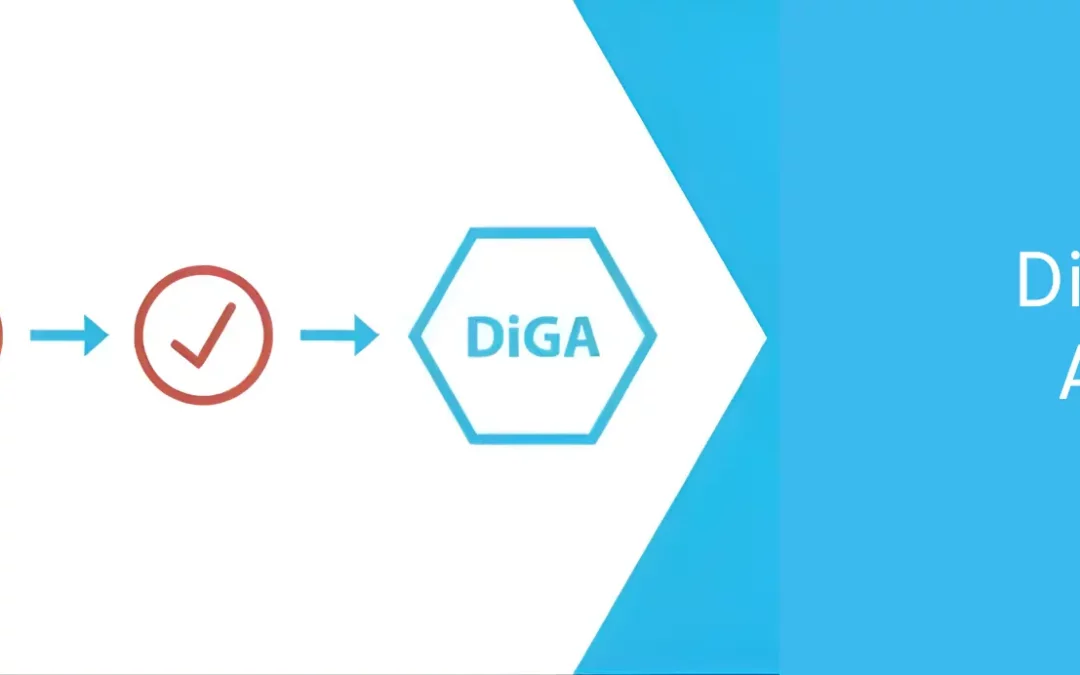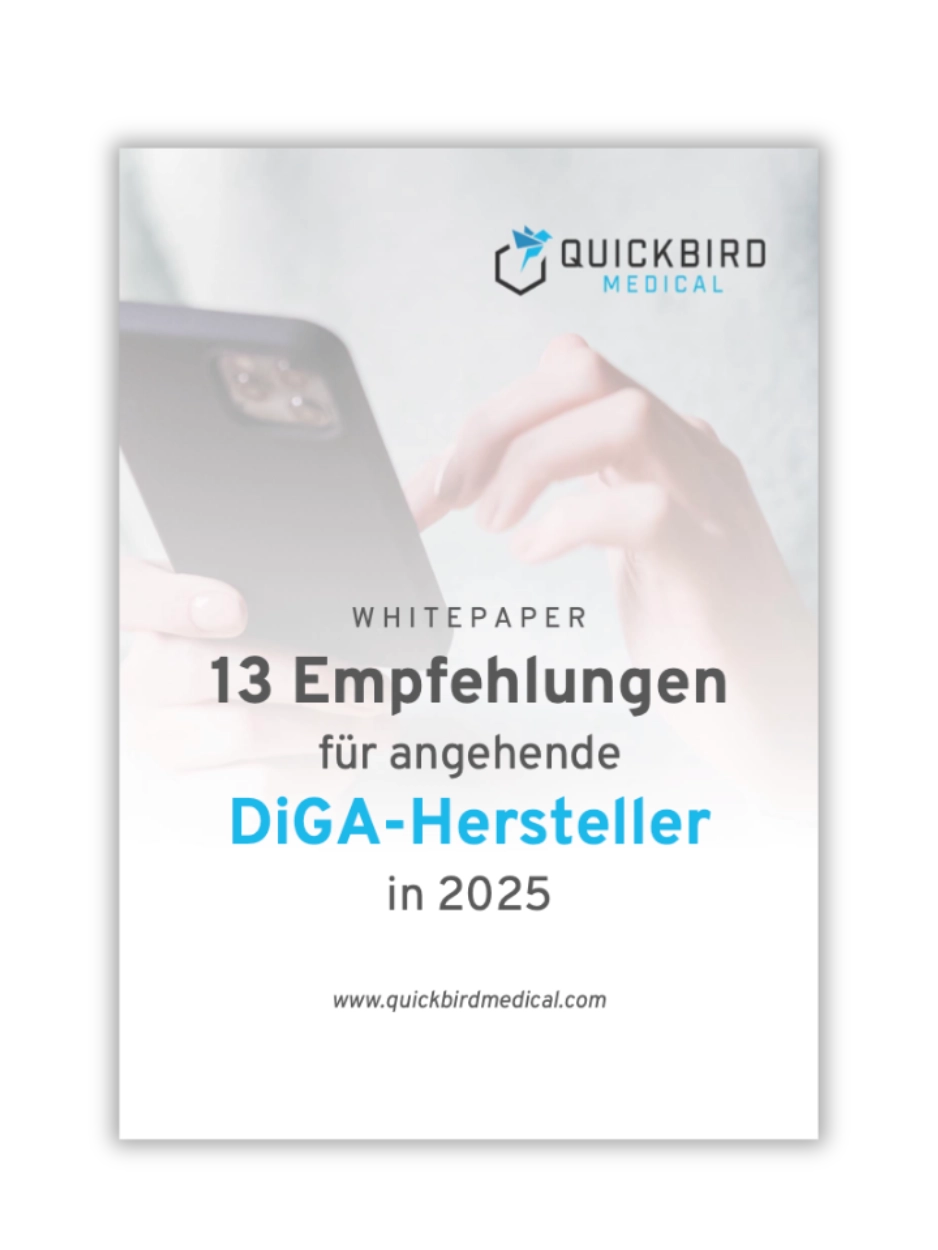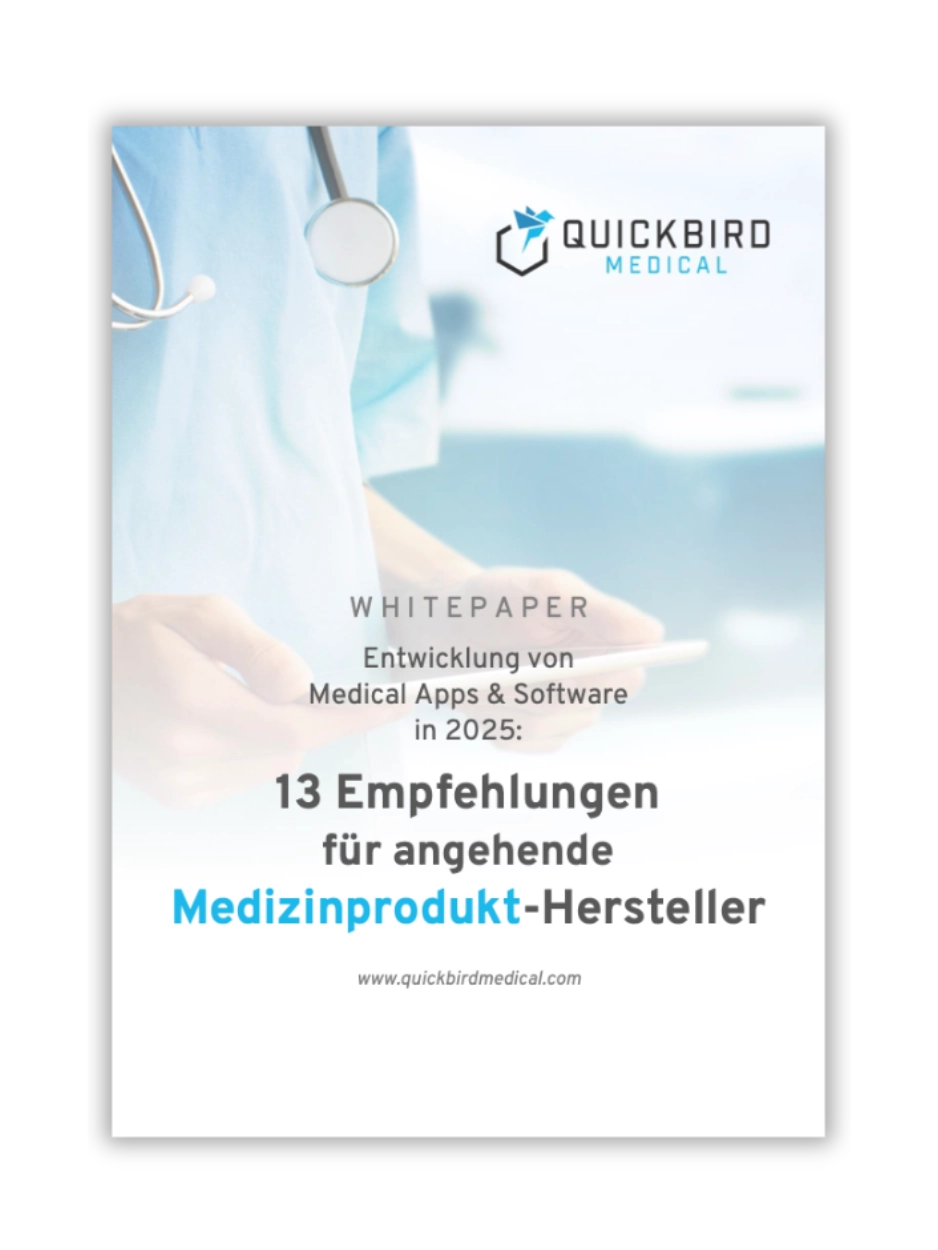The Digital Supply Act came into force on December 19, 2019. One of the biggest changes: Digital health applications (DiGA) can now be reimbursed by statutory health insurance companies if they meet certain requirements. To do this, the manufacturer of the healthcare application must submit an application to the BfArM (Federal Institute for Drugs and Medical Devices) to check these requirements in order to be included in the DiGA directory and thus be eligible for reimbursement.
But what requirements does a DiGA actually have to meet? How does the application procedure work? What does it all cost? Questions like these are currently occupying many companies planning a medical app or medical software. The Digital Health Applications Ordinance (DiGAV) aims to regulate such issues. It came into force on April 20, 2020.
The DiGAV provides very precise information on the requirements for apps. As a software service provider, we specialize in the development of medical apps. The DVG and the DiGAV are therefore a major topic for many of our customers. In this article, we cover the most important contents of the DiGAV. If you are planning to develop a digital care application (DiPA), read our DiPA guide.
Table of Contents
1. Links to DiGAV
You can find the DiGAV in various formats here in advance, in case you want to look up certain things in this guide in detail later:
- DiGAV available online as HTML
- DiGAV table of contents available online as HTML
- DiGAV as PDF file
- DiGAV as EPUB
If you need more detailed information on specific topics after reading this article, it is worth taking a look at the official BfArM DiGA guide (141 pages).
2. Contents of the Digital Health Applications Regulation (DiGAV)
Important: All information in this article is provided without guarantee. We are not lawyers offering legal advice. The contents of this article are the result of intensive research, which may of course still contain errors.
In the following, we will go through all the topic blocks of the DiGAV in a structured way to give you a better overview. We summarize each topic block of the DiGAV here and show you where you can find more information on the respective paragraph. All the points of the DiGAV are presented here for you at a glance (we have grouped the points of the DiGAV thematically in order to deal with similar points together):
- Problem, objective, solution of the ordinance
- Requirements for DiGA
- Requirements for security, functionality, data protection, data security and quality of digital health applications
- Requirements for proof of positive supply effects
- Application
- Application procedure at the Federal Institute for Drugs and Medical Devices (BfArM)
- Application contents
- Advice from the BfArM
- Content and publication of the directory for digital health applications
- Fees and expenses
- Display of significant changes
- Arbitration
2.1 Problem, objective, and solution approach of DiGAV
The problem: Currently, insured persons usually use digital health applications entirely at their own expense. In addition, patients have no structured information on the services and quality of digital health applications or whether the application meets certain data protection and data security requirements.
The solution and the goal: A central directory for digital health applications is being set up. Only applications that meet the requirements for security, quality, data protection and data security will be included in this directory (known as the DiGA directory). They must also provide evidence of positive healthcare effects. To this end, there is an independent, structured and reliable test procedure that ensures long-term compliance with the defined requirements. The directory is user-friendly and transparently accessible to patients.
A comment from us: A few companies have already had laboriously worked out selective contracts with health insurance companies to enable the reimbursement of their applications. However, this is the exception rather than the rule. In addition, such contracts must be negotiated separately with each individual health insurance company. As a manufacturer, the DVG gives you access to all health insurance companies via a standardized process.
Patients are currently struggling through an unorganized jungle of certificates when researching the quality, data protection and data security of healthcare applications. The DVG is intended to provide a uniform “stamp of quality” for the fulfillment of all these criteria.
2.2 Requirements for DiGA
As a manufacturer, you will probably be most interested in the specific requirements that your medical app or medical software must meet in order to be included in the DiGA directory. Among other things, the DiGAV contains a very specific questionnaire in Appendix 1 that asks about these requirements in detail.
To give you an overview, we have listed the categories of all requirements mentioned in the regulation.
2.2.1 Requirements for security, functionality, data protection, data security, and quality of digital health applications
Firstly, the DiGAV sets requirements for the security, functionality, data protection, data security and quality of digital health applications:
- Safety and functionality requirements
- Data protection and data security requirements
- Quality and interoperability requirements
- Robustness requirements
- Consumer protection requirements
- User-friendliness requirements
- Requirements for the support of service providers
- Requirements for the quality of medical content
- Patient safety requirements
In order for your app to be reimbursable under the DVG, it must be a medical device in a lower or higher risk class. Therefore, you must already meet many of these criteria (according to MDR or MDD). We explain how you can decide whether your application is a medical device in a separate article. Our article on formulating the intended purpose will help you with this, and you can then find the correct risk class in our corresponding MDR guide.
You can also find more information on the development of medical apps in one of our medical app development guidelines. The really relevant part of the DVG for you will be the proof of positive care effects, which we explain in the next section.
More details in section 2 (§3 – §7) of the DiGAV
2.2.2 Requirements for proving positive supply effects
Secondly, the DiGAV sets requirements for the proof of positive supply effects. It first goes into what exactly is meant by the term. The correct presentation of these positive supply effects is then specified in more detail. The DiGAV also deals with studies to prove positive supply effects. If you do not have such studies available at the time of application, you must also submit a scientific evaluation concept with which you will evaluate the supply effects at a later date.
More details in section 3 (§8 – §15) of the DiGAV
2.3 Application
The DiGAV also explains how the application for inclusion in the DiGA directory works and what it should contain.
2.3.1 Application process
After the application has been submitted, the BfArM must confirm receipt of the complete application documents to the applicant within 14 days or request the completion of missing documents. If you are not yet able to provide sufficient evidence of a positive supply effect at the time of application (e.g. through clinical studies), you can apply for a trial phase. The BfArM decides how long this trial phase lasts.
You must provide evidence of a positive supply effect by the end of the trial phase at the latest. If you are unable to do this, you must provide sufficient justification. If you can reasonably demonstrate why you still need more time to prove the positive supply effect, the trial phase can optionally be extended by up to 12 months.
More details in section 4 (§16 and §17) of the DiGAV
2.3.2 Inhalt des Antrags
The application contains information on the following points, among others:
- Manufacturer and identifying features of the DiGA
- Medical purpose
- Associated notified body (if applicable)
- Instructions for use
- Objectives, content and use of the DiGA in a generally understandable form
- DiGA functions
- Medical institutions and organizations involved in the development (if applicable)
- Sources for implemented medical content and procedures, in particular guidelines, textbooks and studies
- Existing or planned proof of positive supply effects
- Definition of the patient group
- Existing or planned evidence of positive care effects for the defined patient group
- Study(ies) to prove positive supply effects
- Diagnostic instruments used in the study to determine test accuracy (if applicable)
- Associated manufacturer-independent institution (if applicable)
- Fulfillment of the stated requirements for DiGA
- User roles provided for in the DiGA
- Quality-assured use of the digital health application including exclusion criteria for use
- Medical services required for the application of the DiGA
- Minimum duration of use of the DiGA
- Data processing locations
- Compatibility commitments such as supported platforms and devices as well as required additional products
- Standards and profiles used to create semantic and technical interoperability
- Sum insured under the liability insurance taken out by the manufacturer for personal injury
- DiGA prices
More details in section 1 (§2) of the DiGAV
2.3.3 Advice from the BfArM
The BfArM advises you as a manufacturer on the procedure and the information and evidence to be submitted with the application. This includes, in particular, advice on the proof of positive supply effects and the correct notification of significant changes (after inclusion in the DiGA directory). This is of course subject to a fee.
Specifically, the BfArM organizes consultation days and workshops in Germany, for example.
More details in section 6 (§23) of the DiGAV
2.4 Contents and publication of the directory for digital health applications
The directory for digital health applications is published on the Internet and is intended to ensure greater transparency and clarity. The directory has already been published and can be viewed here.
For each DiGA, information is published on…
- proven or demonstrable positive supply effects
- studies presented, including a reference to the place of publication of the studies
- Sensitivity and specificity of the diagnostic instruments of the DiGA
- remuneration amounts
- Additional costs
- necessary medical services
More details in section 5 (§20 – §22) of the DiGAV
2.5 Fees and expenses
The DiGAV deals specifically with fees and expenses. In summary, you can roughly expect costs of between 3,000 and 10,000 euros for the decision to be included in the DiGA directory. Fees for information and advice are also listed. This depends on the amount of work involved and costs a minimum of 250 euros and a maximum of 5,000 euros. For subsequent change notifications after inclusion in the directory, you may incur costs of between 1,500 and 4,900 euros (per change notification). Costs are also specified for a possible rejection or withdrawal of the application.
More details in section 7 (§24 – §33) of the DiGAV
2.6 Display of significant changes
As soon as your medical app or medical software has made it into the DiGA directory, you must report any significant changes to the DiGA in good time. A change to your application could mean that it no longer meets the requirements for inclusion in the DiGA directory. This would become visible when those changes are displayed and may lead to removal from the DiGA directory.
However, only changes that have a significant influence on the fulfillment of the requirements for safety, functionality and quality of the medical device, the requirements for data protection and data security or the proof of the positive effects on care or lead to changes in the patient groups for which the positive effects on care have been proven must be reported.
In addition, changes that alter the information published in the DiGA directory must be displayed.
More details in section 4 (§18 and §19) of the DiGAV
2.7 Arbitration
In the event of arbitration proceedings, the DiGAV regulates the procedure and composition of the arbitration board.
More details in section 8 (§34 – §42) of the DiGAV
3. Conclusion
Meeting all the requirements of the DiGAV is not that easy. Especially because every DiGA has to be a medical device, medical app and medical software manufacturers are faced with considerable costs and effort. Although this encourages innovation, it should not be taken lightly as “the easy way to big money”. If you make it into the DiGA directory as a manufacturer despite all the hurdles, you will of course have a strong competitive advantage (precisely because it is not easy to get in). What began in Germany at the end of 2019 is now also being adopted by neighboring France: DiGAs are becoming an export hit – including a French equivalent to the fast-track procedure. Find out more about the DiGA requirements in France in this blog article.
Auch andere Länder, wie Österreich oder Belgien planen die Einführung eines ähnlichen Konzepts.
Uns hat besonders gut gefallen, dass es eine klare Liste von Fragen gibt, die man zur Aufnahme in das DiGA-Verzeichnis beantworten soll. 124 Fragen, viel konkreter hätte man es nicht machen können. Die Fragen wirken sinnvoll und sind eine ideale Checkliste für die Entwicklung qualitativ hochwertiger Medical Apps. Wenn Sie mehr Informationen benötigen, lesen Sie am besten den aktuellen DiGA-Leitfaden des BfArM.
If you are planning a medical app or DiGA and need support with the development, please get in touch with us and we will discuss the whole thing together without obligation. We develop medical apps for companies and research institutions on a contract basis.
Any further questions? Please feel free to call us (+49 (0) 89 54998380) or send us an email (kontakt@quickbirdmedical.com).




